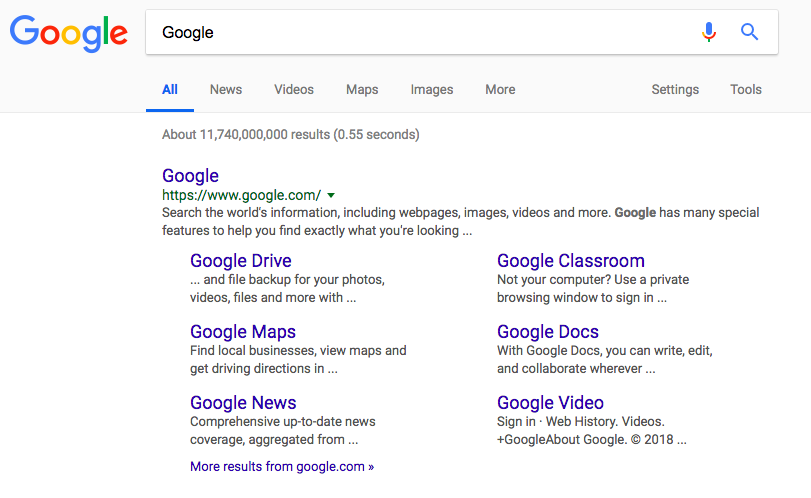You might guess that data science has played a role in your daily life. At Flatiron School, we’re excited about data science and its potential. After all, it not only affects what you do online, but what you do offline. Companies are using massive amounts of data to create better ads, produce tailored recommendations, and stock shelves, in the case of retail stores. It’s also shaping how, and who, we love. Here’s how data impacts us daily.
Data science shapes your online experience
If you Googled today, data science has already affected your life. Google touches everything you do online, so it’s a great starting point to discuss the impact of data science on your daily life. If you search “Google,” you’ll get over 11 billion results before you can blink. It’s not magic, just very smart algorithms and models.

Google has created its own index of the internet and scours that database for any information related to your search in under a second by using multiple search algorithms, according to the company. Google’s algorithms index websites, use literal and semantic meanings of your search term, rank for quality and relevance, along with some personal data to return the best results possible. Google has 15 data centers and other facilities around the world to power its offerings.
A similar process is happening with Facebook and every other social media platform. They are using big data—a fancy way to say the massive amount of data that’s being gathered, stored, and analyzed— to know you better than you know yourself. Facebook has trained its algorithms using every tag, photo, and update posted on the social media network to create a powerful image recognition system. That’s how Facebook suggests friends or who to tag in a photo.There’s another less exciting, but more prevalent, example of data science that impacts everything you do online. It’s in the form of advertising. The ads you see on Facebook, Google, or your favorite website are placed there by an algorithm. It can be because you previously searched for that item or you fit the profile of a potential customer. That data is used to create customer profiles and targeting users based on a whole range of criteria. Even after logging off from the internet, data science is playing a role in how you binge and chill.
Data science in your home
“Alexa, what’s the weather like?” Or maybe it’s Siri or Google. If you’ve used a voice assistant, you’ve interacted with data science in your home. They’re personal assistants who can place orders, give you directions, pause what you’re watching, or play Spotify. Every voice assistant first turns your vocal command into text, according to USC Marshall School of Business. Another program analyzes that text and turns it into a command. That’s possible through machine learning and AI. Every command and every word spoken to an assistant is another opportunity for the AI to get smarter, improve its speech recognition, and provide more accurate results.Even if you don’t have a voice assistant at home, or have avoided smart home tech, data science has a prominent place in your home. If you’ve ever binged, chilled, or found a new show you love through a Netflix recommendation, you can thank data science.What Netflix recommends to you is based on your own viewing habits along with its millions of subscribers around the world, per Wired. Netflix sifts through this data using machine learning and algorithms to create thousands of unique groups. From there, these algorithms look for a common thread in these groups and what you’ve watched to create a unique profile. That’s how Netflix’s recommendation system works and why you can always find something you like on the streaming service.

Whether it’s online or at home, these examples of data science should not come as a surprise. After all, you’re interacting with tech in these scenarios. What’s more surprising is how companies are using big data to create the perfect retail experience.
Stores stocked by data science
You can guess where this is going. After discussing Google, Facebook, and Netflix, it only makes sense to highlight how Amazon uses data science.Amazon’s recommendation system may use different algorithms or grouping methods, but has the same intent as Netflix’s recommendation system. Every purchase, every item placed in a shopping cart or wish list, and every review is used to create a personal recommendation. Your Amazon activity is cross-referenced to purchases made by other customers and new products are recommended.But, Amazon is using data science in ways that you may not see, but directly impacts your shopping experience. Amazon has patented what it calls “anticipatory shipping” that predicts what users may purchase and stocks nearby distribution centers with those items for faster delivery, according to TechCrunch. That’s why there are so many items you can easily get in two-days or the next day. While Amazon using data science makes a lot of sense, big data can also create the ideal retail store. Product placement is already being determined by data and stores have used analytics to identify ideal product locations, according to the Wall Street Journal. IBM has a whole suite of services to optimize the retail experience.You could dismiss data science as just the latest tool that’s selling us something we didn’t want in the first place. But, what happens when it’s love that big data’s selling?
Finding love through data science
If you have tried online dating, you know signing up requires answering personal questions. Tinder requires an active Facebook. These dating sites and apps are using algorithms to find ideal matches and recommending people that appear to be a great fit even if you didn’t think so.Data is powering these matches and connections. We know that Tinder has a lot of data on each of its members thanks to the new European Union data privacy rules that were passed in 2016. One EU user requested her data from Tinder and received over 800 pages of personal information, according to the Guardian. Facebook likes, every match, along with the time and location of each conversation were among the data collected by Tinder.

Each online dating service uses terabytes of data and multiple models to find potential matches. A presentation by eHarmony from 2014 reveals the company creates over 3 billion matches each day based on compatibility, affinity, and timing. eHarmony knows when to send the right match for you at the right time through data science. Tinder uses an “ELO” score, based on the chess ranking system, to determine matches. Factors include how much you swipe, who you’re swiping right on, who’s swiping right on you, and other factors to find potential matches.
A future shaped by data science
Data science is shaping how we interact with the digital and physical world on a daily basis. It’s one of the many reasons why data scientist is the “hottest job” in America. We’re excited to have in-person, online, and introductory data science courses at Flatiron School to train the next generation of data scientists, engineers, and analysts to meet the incredible demand.The influence of data will only continue to expand with even more data from our smartphones integrated into these services. In turn, data science will become increasingly important as companies find new ways to deliver meaningful experiences to users through data. While data is already playing an important role in our lives, get ready for a future fueled by data science. The sky’s the limit when you have algorithms capable of sifting through petabytes of data to find the right answer.




